
Geoje is a city located in South Gyeongsang Province, South Korea. It is located near Busan. Hanwha Ocean in Okpo and Samsung Heavy Industries (SHI) in Gohyeon are both located on Geoje Island. The city also offers a wide range of tourist sights. The city is made up of a number of islands, of which by far the largest is Geoje Island. There are multiple dong in the city: Jangpyeongdong, Okpo-dong and Gohyeon.
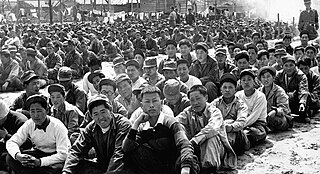
A prisoner-of-war camp is a site for the containment of enemy fighters captured as prisoners of war by a belligerent power in time of war.
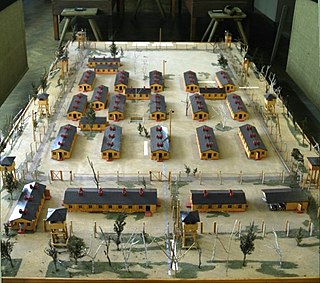
Stalag Luft III was a Luftwaffe-run prisoner-of-war (POW) camp during the Second World War, which held captured Western Allied air force personnel.

Malton is a market town, civil parish and electoral ward in North Yorkshire, England. Historically part of the North Riding of Yorkshire, the town has a population measured for both the civil parish and the electoral ward at the 2011 Census as 4,888.

Stalag XI-B and Stalag XI-D / 357 were two German World War II prisoner-of-war camps (Stammlager) located just to the east of the town of Fallingbostel in Lower Saxony, in north-western Germany. The camps housed Polish, French, Belgian, Soviet, Italian, British, Yugoslav, American, Canadian, New Zealander and other Allied POWs.

The Bowmanville POW camp, also known as Camp 30, was a Canada administered POW camp for German soldiers during World War II located on 2020 Lambs Road in the community of Bowmanville, Ontario in Clarington, Ontario, Canada. In September 2013, the camp was designated a National Historic Site of Canada.

Camp Blanding Joint Training Center is the primary military reservation and training base for the Florida National Guard, both the Florida Army National Guard and certain nonflying activities of the Florida Air National Guard. The installation is located in Clay County, Florida, near the city of Starke in adjacent Bradford County. However, while Camp Blanding utilizes a Starke address, it is located totally within the confines of Clay County. The site measures about 73,000 acres (30,000 ha) and includes Kingsley Lake. It also hosts other Reserve, Army National Guard, Air National Guard, and some Active Component training for the U.S. Armed Forces.

Camp O'Donnell is a current military base and former United States military reservation in the Philippines located on Luzon island in the municipality of Capas in Tarlac. It housed the Philippine Army's newly created 71st Division and after the Americans' return, a United States Army camp. During World War II, the reservation was used as a prisoner-of-war camp for Filipino and American soldiers captured by Japan during its successful invasion of the Philippines. About 60,000 Filipino and 9,000 Americans were housed at the camp. During the few months in 1942 that Camp O'Donnell was used as a prisoner-of-war camp, about 20,000 Filipinos and 1,500 Americans died there of disease, starvation, neglect, and brutality.

Stalag IV-B was one of the largest prisoner-of-war camps in Germany during World War II. Stalag is an abbreviation of the German Stammlager. It was located 8 km (5.0 mi) north-east of the town of Mühlberg in the Prussian Province of Saxony, just east of the Elbe river and about 30 mi (48 km) north of Dresden. From 1944 to 1945 it belonged to the Province of Halle-Merseburg. Now, the area is in Brandenburg. A sub-camp, sometimes identified as Stalag IV-B/Z,Stalag 304 or Stalag IV-H was located at Zeithain, 10 km (6.2 mi) to the south in Saxony.

Featherston prisoner of war camp was a camp for captured Japanese soldiers during World War II at Featherston, New Zealand, notorious for a 1943 incident in which 48 Japanese and one New Zealander were killed. The camp had been established during World War I as a military training camp and had also been used as an internment camp from 1918 to 1920, when 14 German internees remained there.
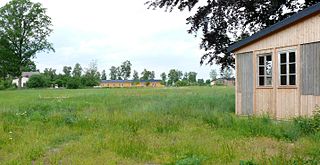
Stalag X-B was a World War II German prisoner-of-war camp located near Sandbostel in Lower Saxony in north-western Germany. Between 1939 and 1945 several hundred thousand POWs of 55 nations passed through the camp. Due to the bad conditions in which they were housed, thousands died there of hunger, disease, or were killed by the guards. Estimates of the number of dead range from 8,000 to 50,000.
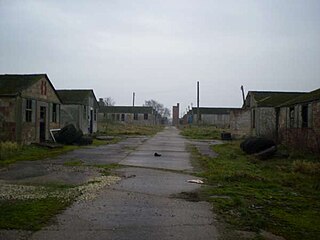
Pingley POW camp is one of the few remaining POW camps in the United Kingdom in good condition. Unlike the nearby Eden Camp which is preserved as a Second World War museum, Pingley Camp lies in a semi derelict state in the grounds of Pingley Farm. It is situated on the outskirts of Brigg, Lincolnshire.
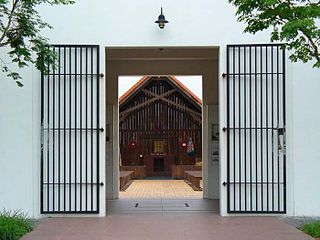
The Changi Chapel and Museum is a war museum dedicated to Singapore's history during the Second World War and the Japanese occupation of Singapore. After the British Army was defeated by the Imperial Japanese Army in the Battle of Singapore, thousands of prisoners of war (POWs) were imprisoned in Changi prison camp for three and a half years. While interned there, the POWs built numerous chapels, one of which was named St George's Church.

Harperley POW Camp 93 is a surviving purpose-built World War II Prisoner of War (PoW) camp built to accommodate up to 1,400 inmates at Fir Tree near Crook, County Durham in the northeast of England. A work camp for low risk PoWs, it was built on a hillside overlooking Weardale and across the valley from Hamsterley Forest. It was built, initially, in 1943 by Italian PoWs to similar plans of other existing Ministry of War Standard Camps of World War II in Britain and was typical of many military installations around the country. It is the main camp for a number of satellite camps, also numbered 93. Nearby Bishop Auckland used Harperley PoWs and Oaklands Emergency Hospital was another installation numbered Camp 93.

The Sandakan Memorial Park is a memorial site built in the former grounds of the former Sandakan camp in the Malaysian state of Sabah. The site is dedicated as a memory for all prisoners in the camp who died during the Sandakan Death Marches, and to those died during a march to Ranau. It is also recognises the suffering and sacrifice of the native population. This park hosts the Sandakan Memorial Day service on August 15.

SS-Truppenübungsplatz Heidelager was a World War II SS military complex and Nazi concentration camp in Pustków and Pustków Osiedle, Occupied Poland. The Nazi facility was built to train collaborationist military units, including the Ukrainian 14th Waffen SS Division "Galician", and units from Estonia. This training included killing operations inside the concentration camps – most notably at the nearby Pustków and Szebnie camps – and Jewish ghettos in the vicinity of the 'Heidelager'. The military area was situated in the triangle of the Wisła and San rivers, dominated by large forest areas. The centre of the Heidelager was at Blizna, the location of the secret Nazi V-2 missile launch site, which was built and staffed by prisoners from the concentration camp at Pustków.

Cowra Prisoner of War Camp Site is a heritage-listed former prisoner-of-war camp at Evans Street, Cowra, Cowra Shire, New South Wales, Australia. The camp was built from 1941 to 1944. It was the location of the infamous Cowra breakout in 1944. The property is owned by the Cowra Shire Council. It was added to the New South Wales State Heritage Register on 2 April 1999.
Lodge Moor was a British military camp based near Redmires Reservoirs, Sheffield, that was best known for housing prisoners of war during World War II. It held approximately 11,000 at its peak, mostly Germans. It was established in World War I for training purposes.
DeWitt General Hospital was a World War II US Army Hospital in Auburn, California, in Placer County at the corner of C Avenue and First Street. The hospital was built in 1944 to care for troops returning home from overseas service and troops that served on the home front. The first patient checked in on February 17, 1944. The hospital had 2,285 beds housed in single story buildings over the 284 acres campus. DeWitt General Hospital was three miles north of downtown Auburn.
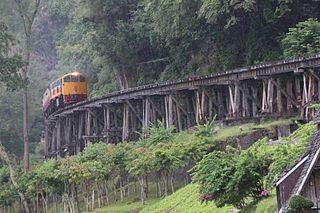
The Wang Pho Viaduct, alsoWampo Viaduct or Tham Krasae Railway Bridge is a railway bridge made of wooden trestles which follow the cliff along the Khwae Noi River. The Wang Pho viaduct was constructed by allied prisoners of war of the Japanese during World War II as part of the Burma Railway. It is sometimes referred as the Double Viaduct, because of a nearby smaller viaduct. The viaduct is still in use and can be reached from the Wang Pho railway station.




















